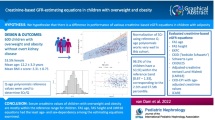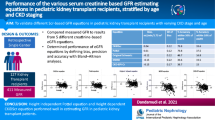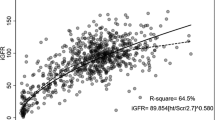Abstract
Background
The Chronic Kidney Disease in children (CKiD) equation to estimate glomerular filtration rate eGFR = k × Ht / SCr (Ht = height in cm, SCr = serum creatinine in mg/dL), with fixed k = 0.413, has recently been optimized by introducing age/sex dependent k-values valid for young children up to young adults (the CKiD Under 25 years (CKiDU25) equation). Although the CKiD equation was designed for children with chronic kidney disease (CKD), this equation found common use both clinically and in research, and also in children without CKD. This report aims to evaluate properties of CKiD and CKiDU25 in healthy children and adolescents.
Method
Sex-specific metadata (height and creatinine) for healthy children were obtained from national growth curves and creatinine versus age curves. These data were used to calculate average CKiD and CKiDU25 values for each year of age and compare them against age-independent measured GFR of 107 mL/min/1.73 m2.
Results
The CKiD estimations show a steep decline with age (1.5 mL/min/1.73 m2/year in females and 2.0 mL/min/1.73 m2/year in males) over the entire age range (2–20 years) and large differences between adolescent males and females. Due to the age/sex specific k-values, the CKiDU25 equation solves this age-decline artifact of the CKiD equation. However, CKiDU25 still shows a systematic higher estimation of about 10% in healthy males compared to females over the entire age range.
Conclusion
Although the CKiDU25 shows major improvements compared to the CKiD equation, as the unexpected age decline has been removed, a systematic difference is still observed between healthy males and females.
Similar content being viewed by others
Avoid common mistakes on your manuscript.
Introduction
Estimating glomerular filtration rate (GFR) in children is mostly done with the Chronic Kidney Disease in children (CKiD) equation, better known as the “bedside Schwartz” equation. This equation has the very simple form: eGFR = k × Ht / SCr, with Ht the height of the child in cm and SCr the serum creatinine concentration in mg/dL. In 1976, Schwartz developed serum creatinine-based equations of this form, for pediatric use, which used age-/sex-dependent k-values [1]. In 2009, this equation was updated because of the evolution in serum creatinine assay development [2]. The equation was designed to be used with creatinine assays which are traceable to the isotope dilution mass spectrometry gold standard methodology. This updated pediatric bedside Schwartz equation uses a fixed value k = 0.413 as the leading coefficient. The data used to develop this equation came primarily from potentially growth-retarded children (with median age- and gender-specific height percentile of 22.8 compared with the median age- and gender-specific weight percentile of 45.3) aged 8 to 15 years with chronic kidney disease (CKD). Notwithstanding the development of the equation with these specific data, this equation is now widely used both clinically and in research, both in children with CKD and in non-CKD children. The data used to develop this bedside Schwartz equation did not allow to evaluate the age/sex dependency of the k-value, as in the older version of the 1976 equation. Already in 2010, we have shown that a fixed k-value is too simplistic and should be replaced by an age-dependent k-value. In the Flanders Metadata equation [3], this k-value was expressed as k = 0.0414 × ln(age) + 0.3018, for children aged < 15 years. This age-dependent k-value was obtained based on Belgian metadata, combining SCr data from our local hospital [4], demographic data obtained from Flanders’ (Flanders being one region of Belgium) growth curves [5], and measured GFR data published by Piepsz et al., also in Belgium [6]. In a recent publication, Pierce et al. [7] revisited the CKiD equation to assess whether the fixed k-value of 0.413 should be modified by sex and age to yield less biased estimates of measured GFR, most notably in young children, adolescents, and young adults. In this new CKiD Under 25 years (CKiDU25) equation, they found that k-values indeed depend on age and sex and presented the following k-values: for males k = 0.390 × 1.008(age−12) for 1 ≤ age < 12, k = 0.390 × 1.045(age−12) for 12 < age < 18, and 0.508 for 18 ≤ age < 25 and for females, k = 0.361 × 1.008(age−12) for 1 ≤ age < 12, k = 0.361 × 1.023(age−12) for 12 < age < 18, and 0.414 for 18 ≤ age < 25. Although the authors have clearly indicated (even in the title of their original publication) that this new equation should be used in children and young adults with CKD, it would not be surprising that this equation would be applied in healthy children too. In this brief report, we therefore want to investigate properties of the CKiDU25 equation using data of healthy individuals and compare it with the older bedside CKiD equation, and the European Kidney Function Consortium (EKFC) equation [8] for males and females in the age range 2–20 years.
Methods
We used the metadata (for the age range 2–20 years) from Pottel’s educational review [9] (presented in the supplement Table S1), which are representative for (Belgian) healthy children and calculated the age/sex dependency of CKiD and CKiDU25. Recently, we established a mathematical relationship, based on fractional polynomials, between average serum creatinine (Q) and age in healthy European (Belgian and Swedish) children, adolescents, and young adults, and used it in the EKFC Eq. (107.3 / [SCr/Q]A, with A = 0.322 when SCr/Q < 1 and A = 1.132 when SCr/Q ≥ 1) [8]. These so-called creatinine growth curves represent the median SCr (called the Q-value) versus age relationship for the ideal healthy male and female in the age range 2–40 years, and can thus be seen as an extension of the metadata. When SCr = Q, the predicted EKFC-eGFR = 107.3 mL/min/1.73 m2, which also represents the average measured GFR among healthy children in this age range [3].
Results
Estimated GFR against age for the CKiD and CKiDU25 equations were calculated for the metadata of healthy children (metadata shown in the supplement), separately for males and females, and presented in Fig. 1.
The main observations from Fig. 1 are (a) the systematic decline in eGFR-CKiD with age from young to older age, with an accelerated decrease in adolescent boys compared to girls and (b) the nearly age-independent evolution of CKiDU25 over the age range 2–20 years, but with a systematic lower estimation at all ages of about 10% on average in females, compared to males.
Supplement Table S1 and Figures S1–5 present the evolution of CKiD, CKiDU25, FM, FAS-Age, FAS-Height, and EKFC with age in the metadata.
Discussion
Kidney Disease: Improving Global Outcome (KDIGO) guidelines currently recommend the bedside Schwartz (CKiD) equation for use in clinical practice [10]. The pediatric GFR calculator instructions on the National Kidney Foundation website [11] mention that “if values for cystatin C and/or BUN are not entered, the calculator will generate GFR estimates using the creatinine-based ‘Bedside Schwartz’ equation only (currently considered the best method for estimating GFR in children).” Thus, KDIGO and NKF do not explicitly mention that the use of the CKiD equation should be restricted to children with CKD. The recently updated “bedside” CKiDU25 equation introduced age-/sex-dependent k-values, because systematic biases in the earlier published bedside CKiD equation with fixed k-value of 0.413 were identified [7]. Indeed, one of the major flaws of the fixed k-value bedside CKiD equation is the systematic decrease in estimated GFR for normal healthy children that follow the average growth curves, and have the ideal age-/sex-specific average creatinine value. Also mGFR is constant and not different in healthy female and male children in the whole age range. Such requirements are clearly not fulfilled for the CKiD equation which shows a steep decline with age from about 125–130 mL/min/1.73 m2 at young age to about 100 mL/min/1.73 m2 at the age of 20 years in females, and even to about 85 mL/min/1.73 m2 at the age of 20 years in males. This is a decrease of 40 mL/min/1.73 m2 over an age span of about 20 years, or a decline of 2 mL/min/1.73 m2/year, which is double the physiological decline observed in adults beyond the age of 40 years [12, 13], making this decline of eGFR in children implausible. These artifacts are particularly relevant in longitudinal studies in healthy and non-CKD children and can lead to serious misinterpretations, both in clinical practice and research. As an example, routine repeated screening in healthy, asymptomatic, low-risk children might be falsely interpreted as a decreasing trend in eGFR over the years when the CKiD equation is used. The recent update with age-/sex-specific k-values in the CKiDU25 equation removes the age-dependent decline, which further stresses the flaw present in the CKiD equation. This is an improvement for the CKiD equations. However, the CKiDU25 equation introduces a systematic difference of about 10% between healthy males and females, over the complete age range (2–25 years). Such systematic difference according to sex is not observed in measured GFR, neither in children nor in adults [6, 14], although there is still controversy regarding the real difference between males and females. As a limitation it should be noted that the growth and creatinine curves used in our analysis were restricted to European (mostly Caucasian) children, which implies that the findings may not fully generalize to other populations.
In conclusion, the new CKiDU25 equation overcomes limitations in the earlier bedside CKiD equation regarding an inaccurate dependency on age in healthy children. However, the CKiDU25 equation is associated with a systematic difference between male and female healthy children, which requires further investigation. Therefore, our analysis demonstrates that the creatinine-based CKiD and CKiDU25 equations are not valid when applied to a population of healthy children. Among other equations (see supplement), the FAS-Height [15] and EKFC equation [8] (which does not require height and can thus automatically be reported by laboratories) do not show such age and sex effects and are therefore preferable in non-CKD children.
Availability of data and material
Data are available from the Supplement.
Code availability
Not applicable.
References
Schwartz GJ, Haycock GB, Edelmann CM, Spitzer A (1976) A simple estimate of glomerular filtration rate in children derived from body length and plasma creatinine. Pediatrics 58:259–263
Schwartz GJ, Muñoz A, Schneider MF, Mak RH, Kaskel F, Warady BA, Furth SL (2009) New equations to estimate GFR in children with CKD. J Am Soc Nephrol 20:629–637
Pottel H, Mottaghy FM, Zaman Z, Martens F (2010) On the relationship between glomerular filtration rate and serum creatinine in children. Pediatr Nephrol 25:927–934
Pottel H, Vrydags N, Mahieu B, Vandewynckele E, Croes K, Martens F (2008) Establishing age/sex related serum creatinine reference intervals from hospital laboratory data based on different statistical methods. Clin Chim Acta 396:49–55
Roelants M, Hauspie R, Hoppenbrouwers K (2009) References for growth and pubertal development from birth to 21 years in Flanders, Belgium. Ann Hum Biol 36:680–694. Growth curves in Flanders. Available at: http://www.vub.ac.be/groeicurven/groeicurven.html
Piepsz A, Tondeur M, Ham H (2008) Escaping the correction for body surface area when calculating glomerular filtration rate in children. Eur J Nucl Med Mol Imaging 35:1669–1672
Pierce CB, Muñoz A, Ng DK, Warady BA, Furth SL, Schwartz GJ (2021) Age- and sex-dependent clinical equations to estimate glomerular filtration rates in children and young adults with chronic kidney. Kidney Int 99:948–956
Pottel H, Björk J, Courbebaisse M, Couzi L et al (2021) Development and validation of a modified full age spectrum creatinine-based equation to estimate glomerular filtration rate. A cross-sectional analysis of pooled data. Ann Int Med 174:183–191
Pottel H (2017) Measuring and estimating glomerular filtration rate in children. Pediatr Nephrol 32:249–263
KDIGO website. https://kdigo.org/wp-content/uploads/2017/02/KDIGO_2012_CKD_GL.pdf. Accessed 10 Sept 2021
National Kidney Foundation Pediatric calculator. https://www.kidney.org/professionals/kdoqi/gfr_calculatorped. Accessed 10 Sept 2021
Delanaye P, Glassock RJ, Pottel H, Rule AD (2016) An age-calibrated definition of chronic kidney disease: rationale and benefits. Clin Biochem Rev 37:17–26
Delanaye P, Jager KJ, Bökenkamp A, Christensson A et al (2019) CKD: a call for an age-adapted definition. J Am Soc Nephrol 30:1785–1805
Pottel H, Hoste L, Yayo E, Delanaye P (2017) Glomerular filtration rate in healthy living potential kidney donors: a meta-analysis supporting the construction of the full age spectrum equation. Nephron 135:105–119
Pottel H, Hoste L, Dubourg L, Ebert N et al (2016) An estimated glomerular filtration rate equation for the full age spectrum. Nephrol Dial Transplant 31:798–806
Author information
Authors and Affiliations
Contributions
HP made the calculations and wrote the first draft. All co-authors made comments and suggestions to improve the report. All authors have read and approved the final version.
Corresponding author
Ethics declarations
Conflict of interest
The authors declare no competing interests.
Additional information
Publisher's Note
Springer Nature remains neutral with regard to jurisdictional claims in published maps and institutional affiliations.
Hans Pottel, Jonas Björk, Pierre Delanaye, and Ulf Nyman are members of the European Kidney Function Consortium.
Supplementary Information
Below is the link to the electronic supplementary material.
Rights and permissions
About this article
Cite this article
Pottel, H., Björk, J., Delanaye, P. et al. Evaluation of the creatinine-based chronic kidney disease in children (under 25 years) equation in healthy children and adolescents. Pediatr Nephrol 37, 2213–2216 (2022). https://doi.org/10.1007/s00467-022-05429-0
Received:
Revised:
Accepted:
Published:
Issue Date:
DOI: https://doi.org/10.1007/s00467-022-05429-0





